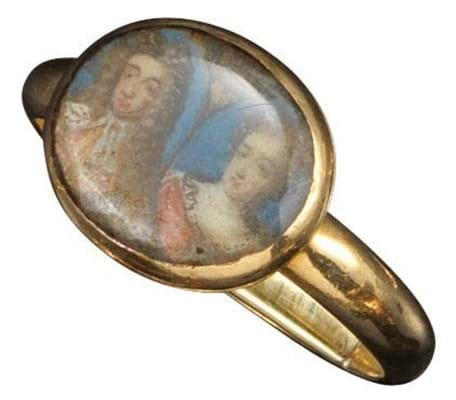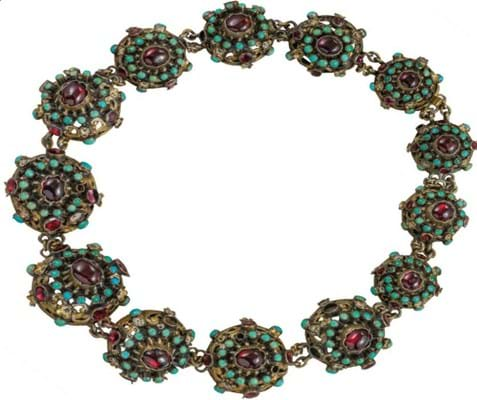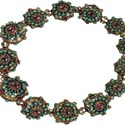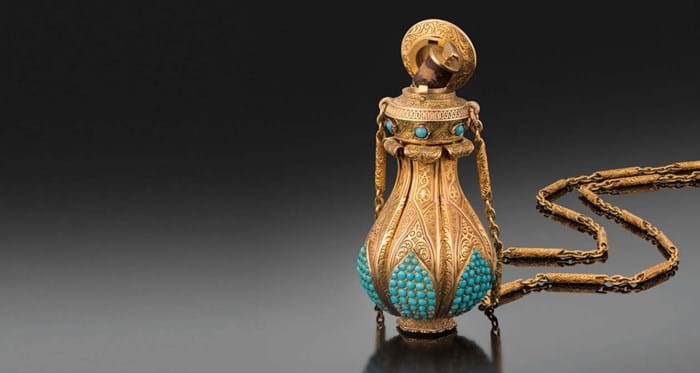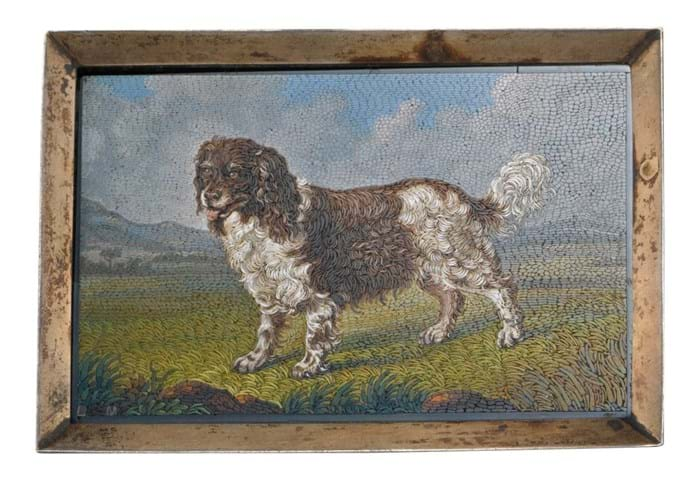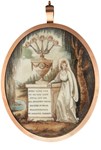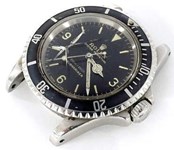Morrell, who enjoyed what today would be called an ‘open marriage’ with her husband, the Liberal MP Philip Morrell, was known to have had many lovers including Bertrand Russell, Augustus John and Roger Fry. In her later years there were brief affairs with a gardener employed at Garsington and a stonemason known as Tiger.
Not quite sex in the woodshed, but the type of behaviour that shaped the Lady Chatterley’s Lover character which, upon its publication, hurt her deeply. In a letter to friend Virginia Woolf, referring to Lawrence she wrote: “I was so angry I could hardly finish his letters.”
Morrell’s taste in jewellery befitted the flamboyant aristocrat, society hostess and patron of the arts: gem-set necklaces, girondolle earrings and Holbeinesque pendants.
“It was a wonderful collection to handle predominantly because it was a such an unusual selection from the period,” said head of department Marielle Whiting. “Lady Ottoline favoured eccentricity and drama in her personal life and this was reflected in her choices of jewellery.”
The most commercial entry was an early 20th century fancy yellow diamond cluster ring sold at £7200 (estimate £2000-3000). A Gemmological Certification Service (GCS) report stated that the central cushion-cut diamond weighs around 1.5ct and is a natural fancy-intense yellow diamond with VS clarity and strong fluorescence.
A silver and enamel necklace and matching brooch set with cabochon garnets and turquoise cabochons was that worn, aged 12, by Morrell in a portrait painted by James Sant. Estimated at £150-250, it took £800 from a private collector.
Sale of the centuries
Period pieces made up a significant portion of the sale that attracted a real crowd – some of them squeezed into seats in the aisles and behind the rostrum – and a lot of private buying both from the UK and internationally.
Among the earliest items in the sale was a late 17th century ring mounted with an oval miniature portrait of William and Mary under rock crystal, sold to a dealer bidding for a private collector at £4500 (estimate £2000-3000).
It was sold with a copy of a catalogue for the exhibition Parliament and the Glorious Revolution: 1688-1988, held at the Banqueting House, Whitehall in 1988. The catalogue said exhibit 18 had been presented to Jean Stuart Campbell, lady-in-waiting to Mary II.
There was competition to £7000 (estimate £3000-4000) for a late 18th century ring worked with a finely carved and coloured ivory coastal scene. To the left was a fisherman and to the right a French man-of-war flying the tricolour.
A little earlier, and sold at the lower end of a £4000-6000 estimate, was a pendant incorporating an enamelled tea party scene – four seated women drinking tea attended by a black servant – of a type familiar to students of mid-18th century English pottery. A similar pendant is in the Victoria and Albert Museum.
A gold, turquoise and peridot pomander was exceptional both in terms of size and quality.
The 3in (8cm) high baluster form opens to reveal six ‘petals’ that each house a double-sided vinaigrette, while a scent bottle is concealed in the upper section. A large hexagonal peridot was set to its base.
Pomanders of this form were common among the wealthy in the Stuart period and occasionally appear in silver sales but this (probably French) example was designed to cope with the obnoxious aromas of Victorian Britain.
It was guided at £18,000-25,000 but bidding continued to £32,000. The buyer was the New York dealership Kenneth James Collection.
“It was in beautiful original condition,” said Whiting. “We have never sold anything in the past which begins to compare to this example and it really is a collector’s piece.”
Moglia mosaic
What market movements has he observed? “What I consider the more ‘manly’ side of jewellery such as cameos, intaglio, micromosaics and objet are getting more of a following and fetching stronger prices than previously,” Whiting said.
A micromosaic plaque 2½ x 1¾in (6.5 x 4.5cm) c.1830 depicting a spaniel in a landscape sold at £6200 (estimate £1000-1500), bought by an Italian via the internet, underbid by 12 phone lines.
It was signed LM for Luigi Cavaliere Moglia (c.1813-78), a gold medal winner at the 1851 Great Exhibition whose exceptional skills in the medium included the use of curved tessera to create tufts of grass or curls of fur. He receives a healthy entry in Micromosaics The Gilbert Collection by JH Gabriel.
The vendor (full disclosure: this writer) had bought it earlier this year in an online sale for a tenth of the hammer price. It had been incorrectly catalogued as an oil on copper but was in good company: Arthur Gilbert himself mistook his very first micromosaic for a painting and, after taking it home to show his wife, had to convince her that he had not bought a heavily cracked oil.
The sale was topped at a mid-estimate £80,000 by a Bulgari diamond cluster ring sold with its original drawing dated 1961.
Centred by a brilliant-cut stone weighing 8.15ct, it was one of two major diamond lots closing the sale that were previously owned by Norman Loudon, erstwhile owner of the Shepperton Studios in Surrey.


